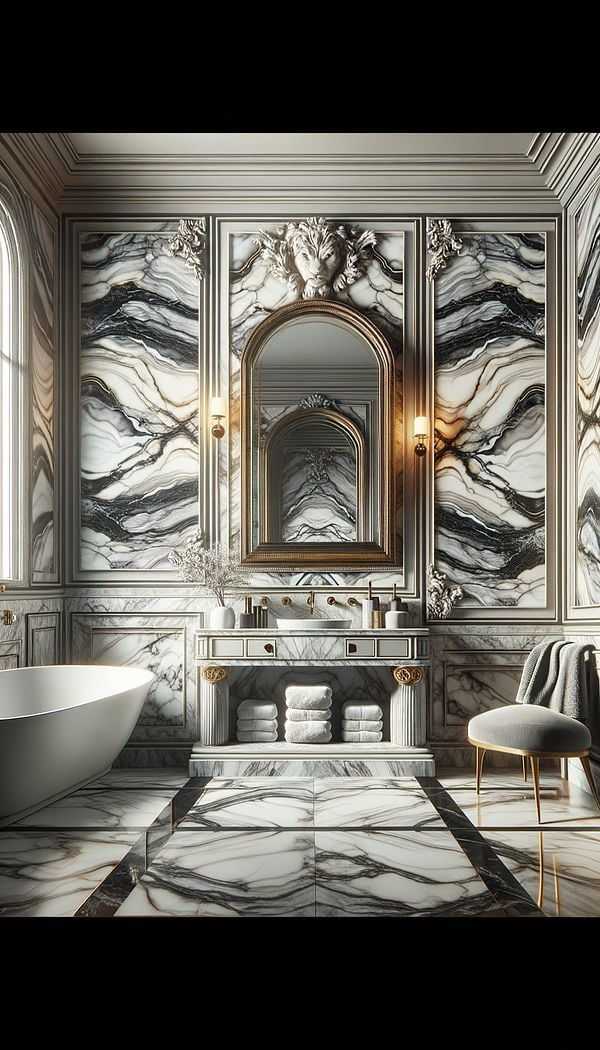What is Book Match?
Book Match refers to a mirror-like reflection technique used in the placing of two matching surfaces.
Description
Book Match is a term commonly used in interior design to describe the methodology of matching two adjoining surfaces so that they mirror each other, resembling an open book. This technique is often applied to materials with natural patterns, such as stone, wood, or marble, where adjacent slices are polished and laid next to each other to create a continuous, symmetrical pattern. The process enhances the natural beauty of the material, elevating the aesthetic appeal of a space through the creation of visually striking patterns.
This artistic approach is not only limited to natural materials. It can also be utilized with man-made materials like tiles or veneers, offering endless creative possibilities for designers and architects. By strategically placing these matched materials, they can transform an ordinary space into a visually compelling environment. Book Matching requires a keen eye for detail and a thorough understanding of the materials to ensure the patterns align and the overall design coherence.
Whether applied on a grand feature wall, flooring, or smaller accent pieces, Book Match can add drama and depth to any space, making it a popular choice among design professionals.
Usage
In luxury homes, Book Match is often seen on large statement walls, particularly in areas like the entryway or living room, where a dramatic effect is desired. It's also common in bathrooms and kitchens, where backsplashes or countertops made from book-matched marble create an elegant and cohesive look. In commercial spaces, such as hotels or corporate headquarters, this technique may be used to create impressive lobby walls or conference room features.
FAQs
-
Can Book Match be used with any material?
While Book Match is typically associated with natural materials like stone and wood, it can be applied to any material that features a natural or designed pattern which can be mirrored, including man-made tiles and veneers.
-
Is Book Match more expensive than regular material placement?
Yes, due to the additional labor and the careful selection of materials needed to ensure patterns match and align perfectly, Book Match can be more costly than standard material placement.
-
How do I choose where to apply Book Match in my design project?
Consider using Book Match in areas where you want to create a focal point or add dramatic effect. It's best suited for surfaces that can showcase the symmetry and natural beauty of the material, such as walls, floors, or countertops.
Practical Application
When planning to incorporate Book Match into a design, start by selecting the right material with a pattern that lends itself to this technique. Consider the scale of the pattern in relation to the space. For large areas, bigger patterns create more impact, while smaller, intricate patterns work well for accent pieces. Always consult with a professional to ensure the best outcome, as the uniqueness of each piece of material can affect the overall effect.
-
Architectural Elements199 articles
-
Decorative Techniques322 articles
-
Fabrication & Craftsmanship133 articles
-
Materials & Textiles360 articles
-
Wall Treatments & Finishes157 articles
-
Semi-Aniline LeatherSemi-Aniline Leather is a type of leather treated with a small amount of pigment retaining its natural look.
-
GeorgianGeorgian architecture and interiors denote the styles that were popular in Britain during the reigns of the first four Georges, from 1714 to 1830.
-
Dado RailA dado rail is a horizontal strip of molding attached to a wall, typically around waist height.
-
Tongue & GrooveTongue & Groove is a method of fitting similar objects together, edge to edge.
-
CohesiveCohesive refers to a design that appears unified and harmonious, with all elements working together effectively.
